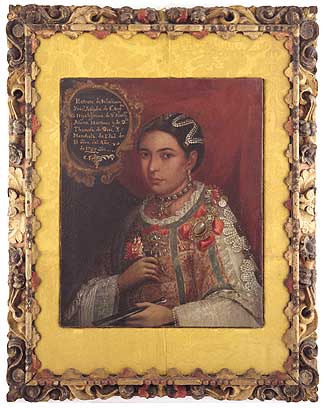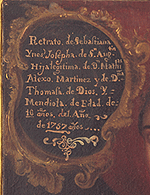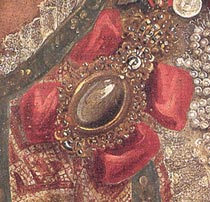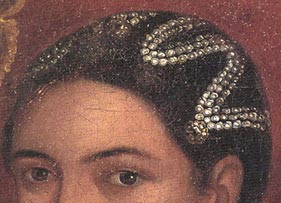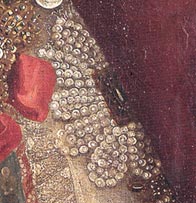
Portrait of an Indian Lady, Daughter of a Cacique, 1757
Students begin by answering the questions from the criteria. The teacher may provide some information given below if needed, but clues from the picture should provide most of the information.
Information about this portrait:
The young woman depicted here is an indigenous noblewoman. The inscription says that she is Sebastiana Ynes Josepha de San Augustin, sixteen years old, and she is about to enter a convent. This young woman's father was an indigenous governor. The portrait was painted in 1757, and it reflects, again, the blending of cultures in New Spain. Her white blouse is a traditional indigenous huipil. Over it, she wears a bodice decorated with two-headed eagles, a European motif, and Chinese silk ribbons, called "galloons." The sleeve of her huipil is embroidered with pearls, and pearls decorate the double band that fastens her hair.
The inscription says that the portrait represents Sebastiana Ynés Josepha de San Augustin, the 16-year-old-daughter of Mathías Alexo Martinez and Thomasa de Dios y Mendiola.
The mesoamerican cultures in Mexico had sophisticated political and social hierarchies at the time of the Conquest. Some local rulers retained their rank and power after the Conquest, though subject to Viceregal authority.
This young woman's father was one such ruler, and as such, a powerful and respected man. His high status enabled his daughter to enter an elite Catholic convent run exclusively for indigenous women.
Historical Information relevant to this portrait:
A traditional, woven Mayan blouse, embroidered with patterns distinctive of a particular town or region. A woman's choice of huipil has symbolic and ceremonial significance, as well as being an expression of fashion. The Mayans believe that what one wears has magical transformational properties with the wearer.
For more information:
Read Maya Textiles of Guatemala by Margot Blum Schevill.
Univ of Texas Pr; ISBN: 0292776659
Visit Woven Voices: Textile Traditions of the Highlands Maya
http://www.anthro.fsu.edu/wovenvoices/weaving/huipil.htm
A narrow band or braid used as trimming and commonly made of lace, metallic thread, or embroidery.
[French galon, from Old French galonner, to decorate the hair with ribbons.]
These pearls may have been imported from China, but natural pearls were so rare and expensive that they were reserved almost exclusively for the noble and very rich.
Both the Incas and Aztecs prized pearls for their beauty and magical powers. Spanish explorers of the New World found the natives in possession of rich pearl fisheries. Along both the Atlantic and Pacific coasts of Central America, the Spanish forced slaves to dive for pearls so the pearls in this painting may be from that area. The English colonizers along North America's Atlantic coast and French explorers to the north and west, all found native Americans wearing pearls, and they discovered freshwater pearls in the Ohio, Mississippi, and Tennessee River basins. So many gems were exported to Europe that the New World quickly gained the appellation "Land of Pearls." (Ward, 2001)
decorating her sleeveFor more information:
- PBS: History of the Pearl by Fred Ward
http://www.pbs.org/wgbh/nova/pearl/time.html- Math/science extension activity for pearls: How Many Pearls?
http://www.pbs.org/wgbh/nova/pearl/uncountable.html- American Museum of Natural History: Pearls in Human History
http://www.amnh.org/exhibitions/pearls/history/index.html- Imperial: History of Pearls
http://www.imperial-deltah.com/visitors/visitorsguidetopearls/vistorsguide.htm
This site has an excellent movie of the history of pearls.Fans
By the 15th and 16th centuries, Chinese artists began making folding fans. Previously Chinese fans were stiff circles or made of feathers. These folding fans were about 12 inches to 14 inches long, including the ribs and more than half the surface was covered by the mounted paper. The 18th and 19th centuries in China saw the production of fans solely for the export market. These fans were made by the Chinese to cater for 'barbarian' tastes and were not used by the Chinese themselves.
The first folding fans were reserved for Royalty and the nobility and, as expensive toys, they were regarded as a status symbol. Whiles their "montures" (i.e. sticks and guards) were made from materials such as ivory, mother of pearl and tortoiseshell, often carved and pierced and ornamented with silver, gold and precious stones, the leaves were well painted by craftsmen who gradually amalgamated into guilds.
For more information:
- The Fan Museum: The History of the Fan
http://www.fan-museum.org/history.htm- The Worshipful Company of Fan Makers: Gallery of Fans
http://www.fancircleinternational.org/- International Fan Collectors Guild
http://www.hand-fan.org/- The Costumers' Manifesto: 18th Century Fans
http://www.costumes.org/pages/18thfans.ht
